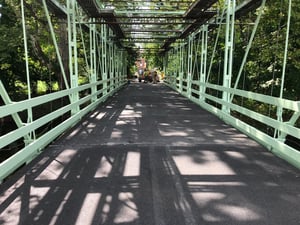 DAYTON, Ohio (November 5, 2018) The infrastructure industry has adopted FiberSPAN fiber reinforced polymer (FRP) as the go-to material for rehabilitation and repair of historic bridges like County Bridge 231 [Peevy Road Bridge]. The Montgomery County, Pennyslvania structure was built in 1880 by Columbia Bridge Works in Dayton, Ohio. David Morrison’s prescient Pratt truss design employed pairs of small rolled I-beams held together by square blocks placed between the sets. In 2016, rusted steel brought the 102-ft. span full circle when Castle Group turned to another Dayton-based company —Composite Advantage—for a lightweight, high-strength fix.
DAYTON, Ohio (November 5, 2018) The infrastructure industry has adopted FiberSPAN fiber reinforced polymer (FRP) as the go-to material for rehabilitation and repair of historic bridges like County Bridge 231 [Peevy Road Bridge]. The Montgomery County, Pennyslvania structure was built in 1880 by Columbia Bridge Works in Dayton, Ohio. David Morrison’s prescient Pratt truss design employed pairs of small rolled I-beams held together by square blocks placed between the sets. In 2016, rusted steel brought the 102-ft. span full circle when Castle Group turned to another Dayton-based company —Composite Advantage—for a lightweight, high-strength fix.
“Most of these bridges used decks made of wood or steel,” says Composite Advantage President Scott Reeve. “Prior to the introduction of FRP, bridge owners had to fight chemical or water damage by installing new wood or steel grid decks or by replacing the whole bridge. Replacement was problematic for communities looking to preserve these historic structures. FiberSPAN helps maintain the integrity and usability of these bridges and can eliminate load ratings that prevent trucks from crossing.”
The design flexibility of FiberSPAN allowed Composite Advantage to accommodate a depth limit dictated by approach roads, match grating depth, meet load requirements and provide a solid surface deck to protect steel undergirding.
FRP panels were 15 ft. wide by 11 ft. long with deck thicknesses that varied from 5 in. to 6 3/8 in. The FRP vehicle deck was built with a flat bottom and a 1.5 percent crown. A 3/8-in. aluminum oxide overlay was applied to the deck panels to provide a safe driving surface capable of supporting large snow plows. Deck connections consisted of 304 stainless steel clips for long term durability. Panel to panel joints were ship lapped, bolted and bonded with MMA adhesive.
The FRP vehicle deck was built to meet AASHTO HS-20 vehicle plus impact loading with a 0.9 environmental durability factor; L/400 maximum deflection, a service load plus dead load with a bending strain/shear strain maximum of 20 percent and a dead load with bending strain/shear strain maximum of 10 percent. Panels were designed for a 100-degree Fahrenheit temperature variation and a minimum fatigue life of 2,000,000 cycles. The panels meet class 2 fire resistance per ASTM 3-84.
Peevy Road Bridge re-opened to traffic in October. FRP will protect the bridge’s steel skeleton and extend the structure’s life by another 100 years.
Composite Advantage supplies innovative fiber reinforced polymer (FRP) products for major infrastructure markets. To create its engineered solutions, CA pairs progressive designs with its capability to mold large parts, perform on-site assembly, and support customer installations. The supplier has been developing lightweight, high-strength, cost-effective FRP goods for structurally demanding applications and corrosive environments since 2005. Many of these products have paved the way for first-time use of FRP composites in infrastructure, rail and water applications because of their performance attributes. CA’s comprehensive lineup includes bridge decks, trail bridges, cantilever sidewalks and rail platforms to fender protection systems, pilings, naval ship separators and other waterfront structures.
Visit www.compositeadvantage.com or contact Composite Advantage at 937-723-9031 or info@compositeadvantage.com.

